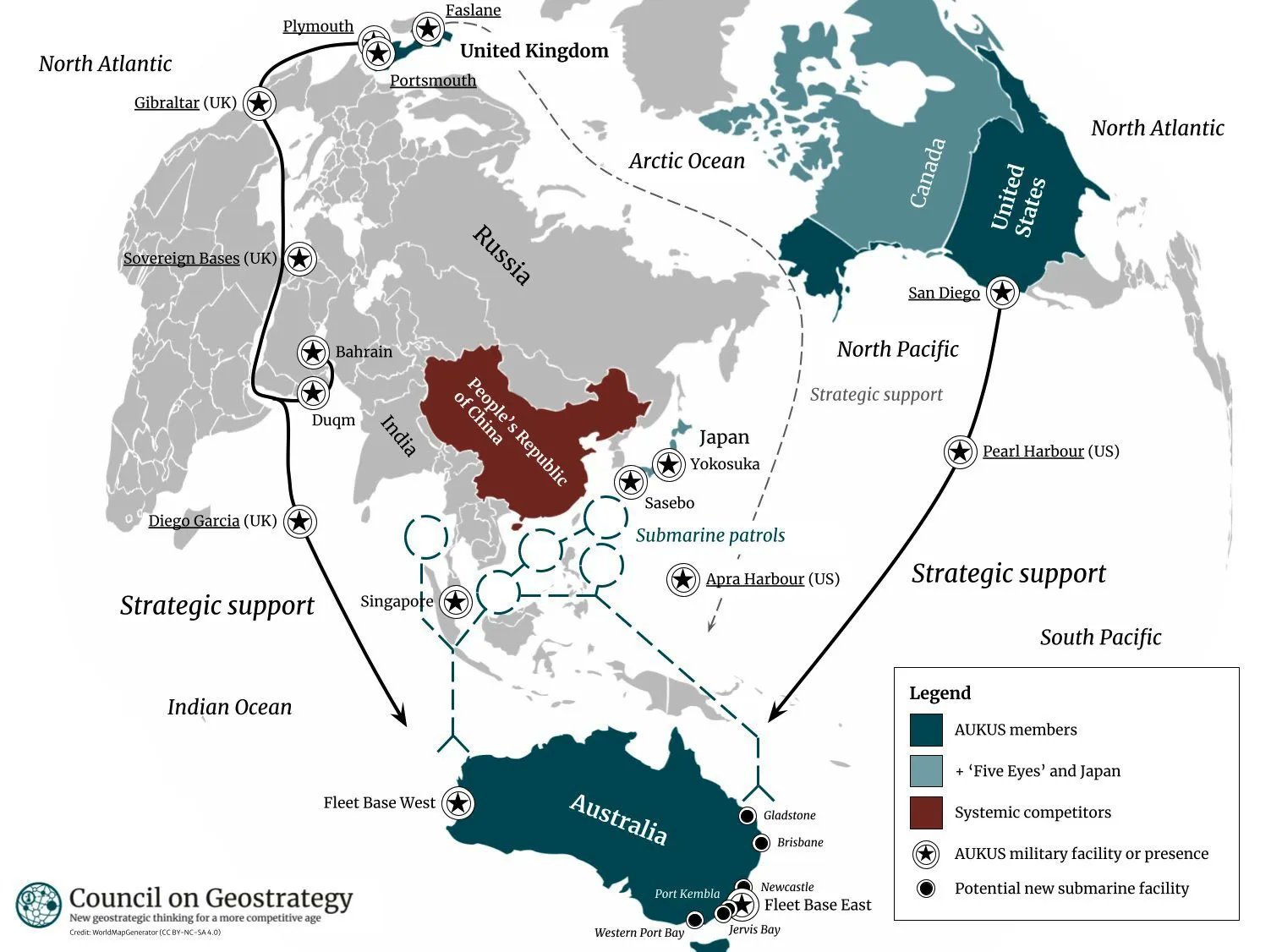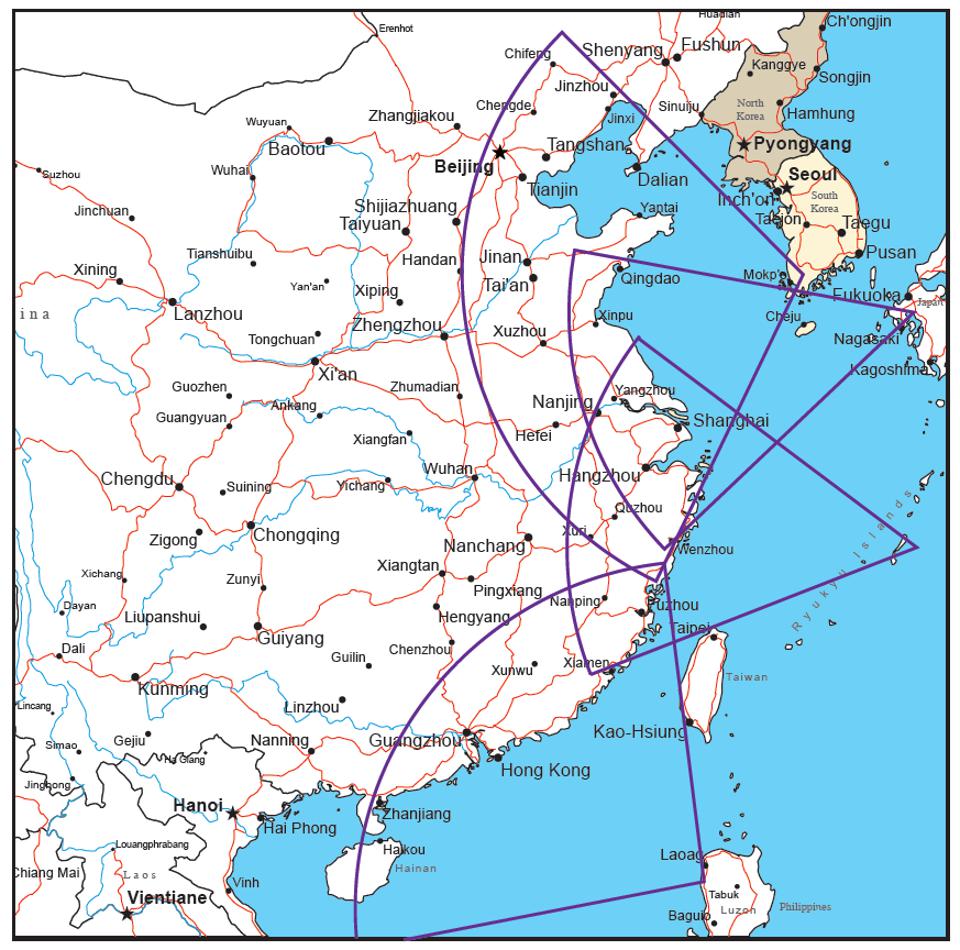The Yuxi Circle and the Drums of War
Commentary by Kathleen Tyson - May 25, 2023
The Yuxi Circle* has a radius of 4000km from Yuxi in the South China Sea. 4.32 billion humans, more than half of all people on Earth, live within the circumference of the Yuxi Circle. More people live inside of the Circle than on the rest of the planet combined.
Content among themselves, indeed agreeing progress toward peace on many borders, they are beginning to prepare for war.
The United States, but also UK, Australia (AUKUS), and Japan are arming for war against China, another nuclear power and the world's second largest economy. US politicians and military planners view war as necessary if US cannot otherwise prevent China's economic rise to regional hegemon or global peer status. AUKUS was agreed by the three states US, UK and Australia without any domestic legislative review, parliamentary or even cabinet approval, the most anti-democratic war-mongering we've seen this century.

The US has been signing up island bases ringing China's coastline, and selling Tomahawks and other offensive weaponry to Japan, Philippines, and Australia. Australia will also purchase nuclear submarines operated by US commanders. Tomahawks are a first-strike missile for taking out runways, ports, infrastructure, shipping. Japan has reversed its defence-only military policy since 1945 to go all-in on ramping up for war. It agreed to buy 400 Tomahawks in December. A four-star US general instructed his officers to prepare for war against China in 2025. UK prime minister Sunak added £5 billion to the defence budget in March for war with both Russia and China and intensified UK military cooperation with Japan.

As long as war never actually happens, the preparations might prove surprisingly useful. War has always spurred innovations, scientific and technological advances.
Chip sanctions led by US and followed less willingly by allies have spurred tremendous progress toward innovative chip design and substitution in China. Huawei alone spent $38 billion on research in 2022 to achieve supply independence, which it will commercialise to global benefit. It has replaced 13,000 parts in its products. China has also taken the lead in AI research and development, likely crucial technology in determining the outcome of the next war.
China is building out solar generation capacity at an accelerating rate to ensure its own energy independence. The sheer scale of production, however, also means the costs of generation are falling for others. It seems likely based on current trend that the world can meet its 2030 solar generation target. That's good for all of us.
Bringing the costs of solar down for China, means bringing the costs of solar down for everyone who wants similar solar generation capacity. Think Africa, South America. It could be a game-changer for sustainable development, education, healthcare, across the developing world.
Then there's food. China has 20% of global population, but less than 10% of arable land. The land China farms degrades as soil becomes thinner, poorer, and more compacted from intensive farming. Aging farmers and migrant workers are difficult to replace as the better-educated young move to cities for work.
Nonetheless, China aims for self-sufficiency in agriculture. A 1996 White Paper set challenging goals. 2022 grain output hit 687 million metric tons, a record high. In February 2023 the CPC's first policy announcement reinforced the priority of agriculture, including science, technology and innovative equipment. As of writing in May 2023, China's staple food self-sufficiency rate is above 100%, and the cereal self-sufficiency rate is above 95%. The longstanding ban on genetically modified crops is giving way, with the first gene-edited soybean pilot approved. Chinese research now leads the world with 75% of crop gene-editing patents to overcome poor soil and harsh climate.
Faced with US hostility, China is diversifying its food imports away from US and 'unreliable' suppliers, shifting imports of wheat, corn, and soybeans to Brazil, Argentina, South Africa. Soybeans were half of US agricultural exports in 2022, a record $16.4 billion. China cancelled its 2023 US orders in April.
China already leads the world in stockpiling food. The US Department of Agriculture estimates holdings of more than 50% of global corn, wheat and other grain stockpiles. Plentiful food stockpiles kept China's inflation low, peaking at 3.4% in 2022, even as rates spiked into double digits for other large importers.
China's self-sufficiency drive is not limited to land, but extends to aquaculture and fisheries. Programs for research and subsidies to aquaculture are rapidly expanding the sector, and innovations offer huge potential productivity gains in growth and disease resistance.
China's drive to modernise, industrialise, diversify its food production and imports is a win for much of the global South if China shares its methods, technologies, machinery, seeds, and fertilisers for development elsewhere. Disruption to food supply chains from the Ukraine war have many political leaders and policy makers looking for better home-grown self-sufficiency.
Russia is another Pacific nation that is intensifying its drive for self-sufficiency. 20 years ago Russia imported most of its food. Now it is a major exporter of grains and foodstuffs for the rest of the world, achieving record exports in 2020, with 150 nations.
Another beneficial preparation is expanding energy pipelines and rail freight lines throughout Eurasia to reduce dependency on shipping lanes. This was always part of the Belt and Road Initiative, but is now accelerating, prioritising new east-west and north-south railways and trade agreements. China and Russia have made many deals this year with neighbours to improve rail transport and pipelines for regional economic security.
China well remembers the US-led export ban and Taiwan nationalist Guanbi policy port embargo in its early history. CIA-assisted ROC naval blockade of Chinese mainland ports triggered economic and social collapse, famine, loss of millions of lives. China is determined to minimise risks and maximise resilience now.
Taiwan is once again central to US war plans. 200 US troops are stationed on the island from March as 'trainers' of the nationalist forces. Weapons sales are up too. Taiwan is being groomed as the next Ukraine by Pentagon planners. Taiwan must prepare not just to defend itself from China, but also from US attacks to destroy its chip industry to deny it to China. Whether unified by peaceful, voluntary reconciliation or invasion, US sees the Taiwanese chip fabs as targets to be destroyed in either event.
US has been intensifying its sanctions on China which have grown massively since the Trump sanctions of 2018. The scale and complexity of economic sanctions are now driving China and the world to seek ways to avoid any US or allied content in design of future products, dividing the world into blocs. Many states and corporations are shifting trade settlements to yuan or other currencies to avoid the risks of dollar trade disruption.
Russia has hardened for war since the start of its Special Military Operation in Ukraine. Its military is larger, better equipped with each passing month. China's military response to the rising threat of war is also impressive. Both Russia and China are nuclear powers, and now both have hypersonic missiles, a technology US and UK do not possess yet. Recent exercises by PLA sank all US naval vessels within range in the first hour of war. Strikes on US homeland targets are also in prospect. While the US could pursue elective wars in Europe, West Asia and North Africa with little objection or impact at home, a war against Russia and China would invite direct attack on US targets, particularly military bases and command posts US has used to operate its recent offensive strikes remotely. 800 bases around the world would also be in scope and at risk.
Most nations in Asia are not yet preparing for war; they remain reliant on stable trade flows, vulnerable to food and energy shocks. Weakened by pandemic and supply chain shocks already, many are in no position to stockpile or diversify supplies as China has done. As AUKUS preparations for war in the South China Sea intensify, these poorer, less prepared nations will have no choice but to increase defence spending and stockpile, despite the likely surge in prices implied by such policies. The alternative is starvation for hundreds of millions should war eventuate.
Ironically, US allies South Korea, Japan and Taiwan are most at risk. They import 90% of energy and 50% of food by sea. This time the blockade may be against their ports if maritime traffic in the South China Sea transit lanes is disrupted.
While the world has stabilised and adjusted to the Ukraine war relatively rapidly, a war in the South China Sea might prove much more disruptive, lastingly harmful. Huge trade flows of both exports and imports would be constrained. Supply chains globally are much more dependent on Yuxi Circle of industrial states than on relatively undeveloped Ukraine. Global economic activity would collapse and inflation would surge.
War in Asia is a global inflation threat too few see looming ever larger on the horizon. In 2022, energy and food drove a sharp upward inflation spike. Add the loss to industry and commerce from supply chain disruptions in the South China Sea and we have a global economic catastrophe for the developed West, the global East, and South as well. There will be no winners.
4.32 billion people are starting to prepare to defend themselves and feed their people in a war not of their choosing. This is not just a threat to half of humanity, it is a threat to all of us.
A new Chinese ambassador arrived in Washington yesterday, speaking on arrival of his mission to achieve win-win outcomes: "We should reject a Cold War mentality and zero sum games." Let's wish him every success. The clock is ticking.
Wow, easily one of the best speeches I've heard on US-China by a Chinese official, impressive!
— Arnaud Bertrand (@RnaudBertrand) May 25, 2023
"I still believe that a sound and stable China-US relationship is in the interest of both countries. It is also the shared expectation of the international community and a major… https://t.co/5AWWaWtelA
*The Yuxi Circle is an adaptation of the Valeriepieris Circle, with a much better geocentric name and population distribution graphic.
